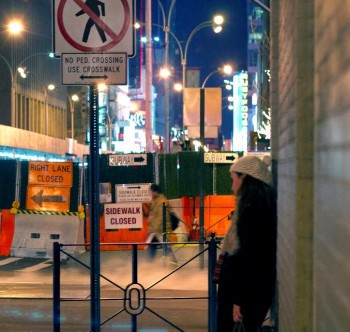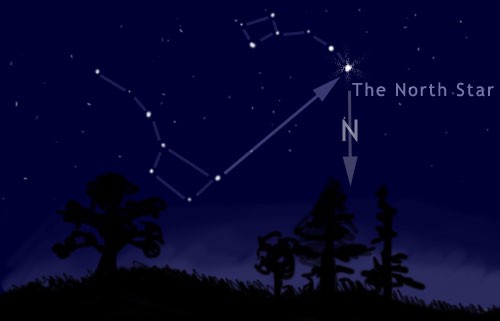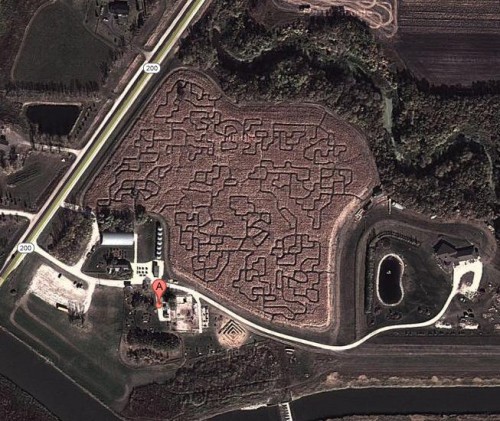How To Get Lost Less Often
How To Get Lost Less Often

No one’s supposed to get lost these days. Smartphones have maps on them — and compasses, too. But phones have a way of losing their signals when you most need them, and then there are the times you simply can’t figure out which street on a crowded map that flipping little blue dot is indicating. And then sometimes your phone dies, and who knew you can’t bike through there, and oh god, the left pedal fell off — and suddenly you’re meeting your boyfriend’s family two hours late and covered in sweat because you took the long way around Arlington Cemetery. Hypothetically.
Or let’s say, you just have a really, really lousy sense of direction, and no phone or GPS system made yet can help you. That’s fine! Lots of people don’t have a great one. But if it makes you tense to be lost or late and you’d like to get better, well, there are ways to actually improve your sense of direction. I know — I’ve done it myself. I’ll tell you how, and after that, just for fun, let’s look at five situations where people frequently find themselves lost and beyond the help of technology — giant parking lots, wandering from a tent at night, walking around a foreign city, or while stuck in a giant corn maze (as sometimes happens) — and explore some ways to orient yourself there.
TIPS FOR IMPROVING YOUR SENSE OF DIRECTION
To flagrantly pilfer the title of a John McPhee classic, the basis of a good sense of direction is having a sense of where you are. So at the most basic level: Look around you and pay attention to the landmarks where you live. Collect them, and note where they are in relation to one another. Once you have collected enough, it becomes a great way to navigate around town. Remembering to “turn left when you get to the place with all the lawn flamingos” will connect in your brain the way “go .3 miles then head north” never will. I like to picture that I’m engaging with a 1:1 scale map and visualize my surroundings from above — that megachurch a block west gets a little sans-serif t, the park up ahead a big block of pale green. So when I’m moving around I have a sense of where I am in relation to where I came from and where I need to be. I am a little blue dot, bleeping my way across town.
When you’re going somewhere new, spend some time with Google Street View and practice your routes. Visually familiarize yourself with, say, the path from the train station to your friend’s house, or your hotel to that cute breakfast place. Then, if you’re going to stay in that new place a while, start collecting landmarks there. I once moved overseas for a short-term work situation, and my first landmark there was a cracked wall that a car had driven into. That wall marked the exact spot that I needed to pull the Stop Requested cord on the bus. By the time the wall was patched up, it was instinct. Also — and this is ideal, if you can swing it — I made a good friend there, a local with a deep knowledge of the area that he was thrilled to share. His stories made the unfamiliar neighborhoods come to memorable life — the overpass a truck got wedged underneath, the curry place that gives everyone food poisoning, the haunted graveyard — locations were given a personal meaning, and I could find my way around solo by remembering his descriptions.
In everyday life, though, I carry a notebook and a writing utensil all the time (this one!). Why not? It takes up almost no space. The paper is more important than the pen here: I’ve taken notes in highlighter, lipstick, even bbq sauce on a toothpick (grass stains, no matter how carefully applied, do not work, FYI). Believe me, you are almost certainly going to smear that address off your hand, so best to write it down somewhere safe (and unsweaty). And do this before you leave the house: you might not have a signal or your phone might die or you might straight up forget where you’re going. I once tried to attend a GIS meetup at a D.C. bar called the Saloon once, but it turned out it was at Stetson’s. Yes, I was late to a geographers’ happy hour because I was at the wrong place. Irony! The point is, knowing vague details (“it’s the western-sounding bar that starts with S on U St”) is not always enough — write it down.
If you’re really serious about wanting to improve your sense of direction and don’t mind dedicating some effort into it, practice makes perfect. Try orienteering! It is, essentially, competitive map reading, and it is a blast. Straight from the US Orienteering website: “In orienteering, you use a map and a compass to locate a series of checkpoints shown on a specialized topo map, choosing routes — on or off trail — that will help you find all the points and get to the finish in the shortest amount of time.” And you know, it’s not even work. I did it once and can recommend it as a possible fun afternoon date, or with friends. And your improved map reading all but guarantees you the navigator front seat on road trips.
But then there are the situations where even a good sense of direction may not be enough or where technology may fail you. The advice here may totally seem like common sense, I know! But dumb things happen to everyone, so you may as well be prepared.
1. A PARKING LOT
Years and years ago, my family went to the mall for some holiday shopping, typical enough, only when we emerged, the minivan was not parked in the usual area. We had a very distinctive van at that point — maroon with a pink lightning bolt down the side — and so if we couldn’t find it, it had to have been stolen. My mom immediately and logically called the police. The nicest cop in the world showed up and gently suggested to my by-then panicky mother that we take a drive around the parking lot — sure enough, it was on the other side of the mall, right where we’d left it. He said it happened at least once a week. We hadn’t parked in the usual location‐the one by the food court (there are always open spots there! Why is that? I guess no one goes to the mall to eat) — because we had to return something heavy.
A little existential backtracking is your friend here: why are you here? Well, a little less existential: why did you go to the mall? The primary impetus for the trip was probably your first stop, and that’ll be where you parked. If that doesn’t work, check the times on your receipts, and investigate the parking area closest to the first store. (Of course, too, if the lot areas are marked, like in a parking garage or amusement park, and you noticed that when you arrived and you’re carrying that notepad…)
2. AT NIGHT

Okay: I’m not a wilderness expert — let’s be clear. I don’t want some desiccated corpse found somewhere, last words scrawled in the dirt beside it VICKY TOLD ME TO GO THIS WA — -, but navigation by star position is simple enough, and it can be a nice activity on a camping trip, try to get your bearings that way. First: locate the North Star/Polaris, shown here. Then find Orion. The rightmost star in Orion’s belt, Mintaka, will always be within one degree of true East (before midnight) or West (after). Using these two stars as your guide, create a mental compass.
In the southern hemisphere, you’ll do basically the same thing with the Southern Cross.
It can be fun to practice with this, and everyone can use a little extra stargazing every now and then. Then if sometime you, say, stumble off into the woods to pee and can’t find your campsite again? Using stars as guide points will prevent you from walking in circles as long as you keep referencing them as you walk. But hey, if you have no star sense and/or it’s cloudy, FFS, it’s dark out — you can pee within sight of the tent. No one will know.
3. A STRANGE CITY
For me, the strange city was Myslenice, Poland, and, as I was a teaching assistant for an English immersion program, it mostly didn’t matter that I only know about ten words of Polish: cusses, names of foods, and “Happy New Year!” None of which are helpful when you’re lost. But all alone and about to miss the midday meal, I blurted “Proszę, szkół?” (May or may not mean “Please, school?”) to a friendly-looking gentleman… and was sent in the opposite direction. Here’s the thing, he clearly did not understand what I was trying to convey. But people are kind, and they want to assist someone who looks distressed.
This happens. In most cases, folks are not going to be intentionally malicious, they just want to help. But not all are good at it, or you may have just said something horribly garbled. So if you’re not for whatever reason confident in the direction giver, ask a few more people — try to get a general consensus. The direction that most of them send you in? That’s likely the direction you should go. This is also, by the way, a good time to have where you’re going written down on paper. If I had been able to show that guy “Szkoła dla głuchego” written out, I probably would not have missed the chłodnik. Mmmm, chłodnik.
Side note: Many American cities have a regular grid pattern with numbered streets, but that’s not true everywhere. Older towns and cities, for example, tend to have centrally located town squares. The major streets will lead outward from the square, and hopefully one of them will have a name you recognize. There’s also likely to be some official presence there, someone whose job it is, in part, to wrangle the directionless.
4. UNFORESEEN DETOUR
So that hypothetical situation about being two hours late to meet a boyfriend’s family? Of course that was me, I’m terrible at coming up with hypotheticals. And if you’re at all familiar with the national capital region, I was biking from Park View, DC, to Del Ray, VA. Google Maps, whose reminder that bike routes are in beta I habitually ignore, sent me through Arlington Cemetery. Did you know that you can’t ride a bike through there? I think it’s the only time I’ve ever had a gun drawn at me. But my phone was dead, my bike was literally falling apart, it was about to rain, and that whole area was as familiar to me as the back of your hand. I was hosed. The best you can do in this situation — or in any similar mess — is use context clues — listen for sirens if you know of a hospital in the area, streets with North and South directionals, anything. In the absence of context clues, backtrack along the exact route you took until you get to a familiar location and reevaluate from there. My context clue was the airport. I knew where National Airport was in relation to where I was and where I wanted to go, so I could roughly triangulate my position by watching planes begin their descent. I backtracked to the bridge over which I crossed the Potomac, where I was able to find the entrance to the Mt Vernon trail, which [side-eye to Google Maps] I should have taken in the first place.
5. LOST IN A CORN MAZE

Okay, so the point of a corn maze is to get lost. Yes. But eventually you have to leave. For this one I actually called a few farms with seasonal corn mazes, and the one that got back to me refused to divulge their secrets. Is corn maze design a secretly cutthroat industry? Anyway: here’s what you should do should you be hopelessly adrift in a sea of stalks: turn left. Corn mazes are designed to trick participants, and studies have shown that most humans will naturally, when confronted with a fork in the road, turn right; the hour I spent last night testing this on satellite images of corn and hedge mazes absolutely proves that clever maze-makers love to play on your instincts. (Side note: I’ve heard that that turning-left tip is also a good strategy for avoiding long lines at amusement parks.) You can also plow through the stalks, but that kind of ruins it for everyone. And hey, if it really comes down to it, you wouldn’t be the first to have called 911.
Previously: The Maps We Wandered Into As Kids and A Reading List For People Who Love Learning About The World
Victoria Johnson is a cartographer. She just added ‘design a corn maze’ to her bucket list. Photo by jason.kuffer.
